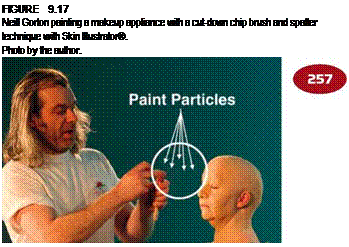An airbrush is a wonderful tool and can create amazing makeup effects in the hands of a skilled user. Airbrushing is not something you can simply become instantly good at; it requires lots of practice, and it requires the right equipment: a dual-action airbrush that allows you to control both airflow and the amount of pigment mixing with the air, and a compressor that’s quiet, consistent, and allows you to regulate the amount of air pressure, from just a few pounds per square inch (psi)—say, maybe 3 psi to at least 10 psi.
More than 10psi will put almost as much pigment into the air around you as on your subject. You don’t want to get a lot of paint or makeup pigment in the air—that’s the same air you’re breathing, so that’s not really good, and you don’t want much air pressure when painting around someone’s face (eyes, ears, nose, and mouth). Think of sticking your head out the window of a car going 20 mph

(32 kph). Airbrushing requires a controlled environment with excellent ventilation. And it’s almost imperative that you have more than one airbrush to use so that you aren’t stopping and starting frequently to refill the brush, clean it, change color, and so on. If you’re working on a show, time is money, and the longer you take. . . well, you get the picture.
If airbrushing is something you’d like to give a whirl, and I know you do, take a class. There is too much to know about how airbrushes work and what safety precautions you need to know to keep a safe and healthy working environment. You’ll find some resources in the appendix at the back of this book.
